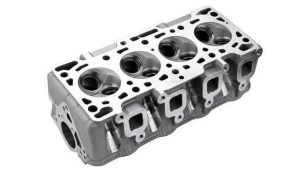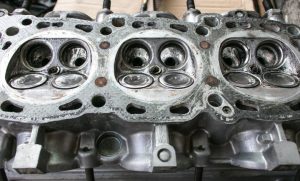The cylinder head is one of the most critical components of an internal combustion engine. It plays a key role in controlling airflow in and out of the engine cylinders, housing vital parts such as valves, spark plugs, and fuel injectors. Understanding the structure and function of the cylinder head — and being aware of common issues — can help you maintain engine performance and prevent costly repairs.
What Is a Cylinder Head?

The cylinder head sits atop the engine block, sealing the top of the combustion chamber. It creates the space where fuel and air mix, ignite, and generate the power that drives your vehicle.
Main Functions of the Cylinder Head
| Function | Description |
|---|---|
| Sealing the Combustion Chamber | Prevents leaks and maintains compression pressure. |
| Housing Engine Components | Holds valves, spark plugs, injectors, and camshafts (in some configurations). |
| Facilitating Airflow | Channels intake air into the cylinder and exhaust gases out. |
| Cooling and Lubrication Paths | Contains passages for coolant and oil to regulate temperature and lubrication. |
Key Components Inside the Cylinder Head
The cylinder head contains several components that work in harmony for efficient combustion and engine operation:
-
Valves (Intake and Exhaust): Open and close to control air-fuel intake and exhaust release.
-
Spark Plugs (in petrol engines): Ignite the air-fuel mixture.
-
Fuel Injectors: Spray fuel into the combustion chamber (in direct injection systems).
-
Camshafts: Operate valves in engines where the camshaft is located in the head (OHC/DOHC).
-
Valve Springs and Rocker Arms: Control valve movement.
-
Gaskets: Provide a seal between the head and engine block.
Types of Cylinder Heads

| Type | Description | Common Use |
|---|---|---|
| Cast Iron | Durable and cost-effective, but heavier | Older vehicles, heavy-duty engines |
| Aluminum | Lightweight with better heat dissipation | Most modern vehicles |
| OHC (Overhead Camshaft) | Camshaft located in the head, improves performance | Modern engines |
| DOHC (Dual Overhead Camshaft) | Two camshafts per head for precise valve control | High-performance engines |
How the Cylinder Head Affects Engine Performance
The design and condition of the cylinder head significantly influence:
-
Combustion efficiency
-
Fuel economy
-
Exhaust emissions
-
Engine temperature management
-
Overall power output
A well-designed head optimizes airflow and combustion, leading to better performance and reduced fuel consumption.
Common Cylinder Head Problems
Over time, the cylinder head can develop issues due to extreme heat, pressure, and wear. Here’s a list of common problems:
1. Warped Cylinder Head
-
Cause: Overheating due to coolant loss or thermostat failure.
-
Symptoms: Loss of compression, rough idling, poor engine performance.
2. Cracked Cylinder Head
-
Cause: Thermal stress or manufacturing defects.
-
Symptoms: White exhaust smoke, coolant in the oil, engine misfires.
3. Blown Head Gasket
-
Cause: Overheating, improper torque, or old age.
-
Symptoms: Milky oil, overheating, bubbling coolant, loss of power.
4. Valve Wear or Damage
-
Cause: Poor lubrication or dirty oil.
-
Symptoms: Tapping noises, misfires, loss of power.
How to Identify Cylinder Head Issues
| Symptom | Possible Issue |
|---|---|
| White smoke from exhaust | Cracked head or blown gasket |
| Engine overheating | Warped head or coolant blockage |
| Oil mixed with coolant | Head crack or gasket failure |
| Engine misfires | Valve damage or poor sealing |
Preventing Cylinder Head Damage
Proper care and maintenance are essential to prolong the life of your cylinder head:
-
Regularly check coolant levels to avoid overheating.
-
Change engine oil and filters on time to ensure proper lubrication.
-
Watch engine temperature gauge to detect overheating early.
-
Use quality fuel and coolant to reduce deposits and corrosion.
-
Inspect head gaskets during major maintenance or engine work.
When to Repair or Replace the Cylinder Head
Repair:
-
Minor cracks can be welded.
-
Warped heads can be machined flat.
-
Valve seats and guides can be replaced.
Replace:
-
Severe cracks or corrosion
-
Multiple valve or seat failures
-
Extensive warping beyond machining limits
When replacement is necessary, it’s crucial to choose a compatible and quality product. You can easily Buy Cylinder Head online and find the right parts for your vehicle model.
Conclusion
The cylinder head is a vital engine component that affects everything from combustion to cooling. Knowing how it works and understanding the signs of trouble can help prevent major engine damage. Whether you’re a DIY mechanic or simply looking to stay informed, taking care of your cylinder head is essential for engine health, efficiency, and performance.
For high-quality parts and replacements, don’t hesitate to Buy Cylinder Head online with a wide range of options available.